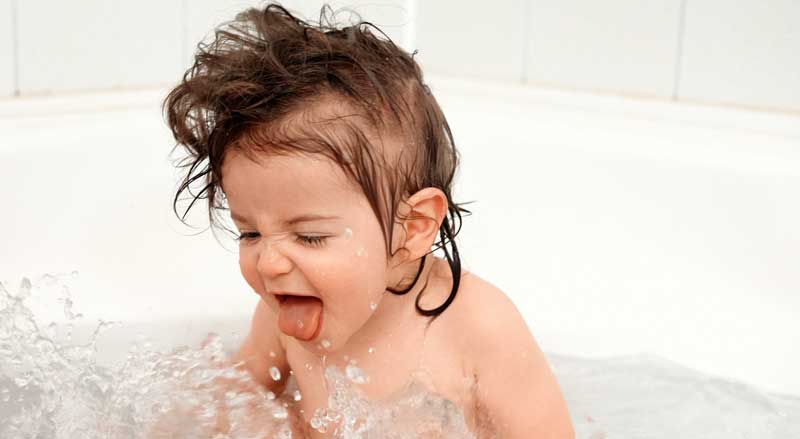Many babies and toddlers love bath time as part of their getting ready for bed routine; it’s a time for relaxation and fun. But it’s also a time when parents need to be extra vigilant about their child’s safety.
According to the Centers for Disease Control and Protection “more children aged 1-4 die from drownings than any other cause of death.” And “among infants under 1 year old, two thirds of all drownings occur in bathtubs.”
These statistics are certainly alarming. But there are many things you can do to make your child’s bath time safe, comfortable, and a fun experience filled with lots of playful splashes and giggles.
Sponge Baths for Baby
The American Academy of Pediatrics suggests that parents give newborns sponge baths for up to two or three weeks after birth, until the umbilical cord stump falls off and the bellybutton is fully healed. Sponge baths prevent infection as the bellybutton heals.
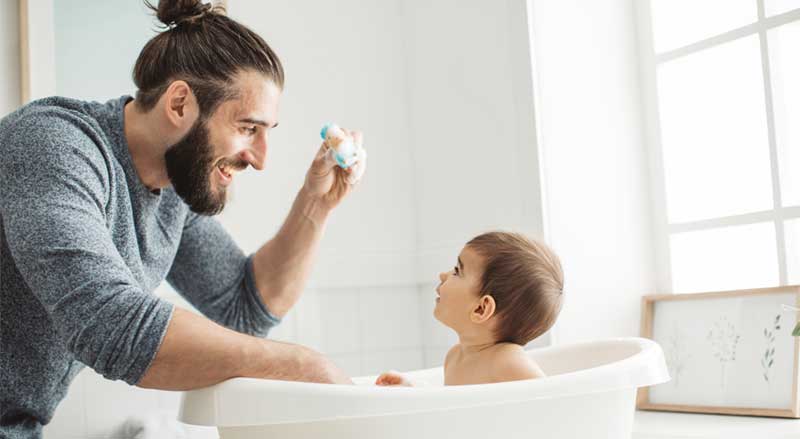
Time to Move to the Baby Tub
Soon baby’s bath time moves up to the baby tub. The baby tub is usually used for kids up to six-eight months, but it all depends on your child’s size and development.
Smaller babies may do well to be bathed in a baby tub for a few months longer. But every child is unique and moves on at their own rate.
You’ll know your baby is ready for the big tub when they can sit on their own and have good body control.
Water in the baby bath should be comfortably warm but never hot. Before you put baby in the tub, test the water temperature with the back of your wrist. If you prefer using a bath thermometer, aim for water that’s 100°F.
The Number One Safety Rule
The number one rule for bath time safety is never leave your baby or toddler alone in the bathtub—not even for one second. This holds true whether your child is in a baby tub or full-sized bathtub.
A baby or young child can drown in just two inches of water—and unfortunately, this can happen fast. Remain vigilant and ignore all distractions like cell phones or tablets.
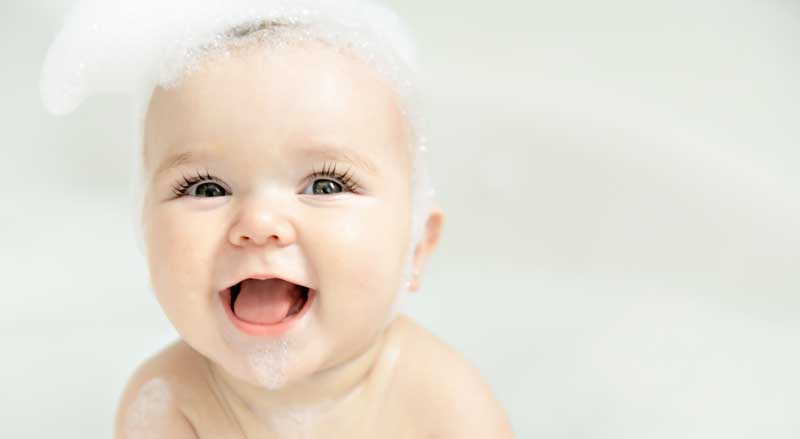
Don’t count on hearing your child from the hallway or from a nearby room if they encounter trouble in the tub. This type of thinking puts your child at risk. Avoid all outside distractions including doorbells and shouts from other children.
If you feel you must leave the bathroom, securely take your child out of the tub, wrap them in a towel for warmth, and bring them with you.
Keep Baby Sitting Securely in the Tub
Once you fill the tub, make sure your footing is secure and then place your baby into the bathtub.
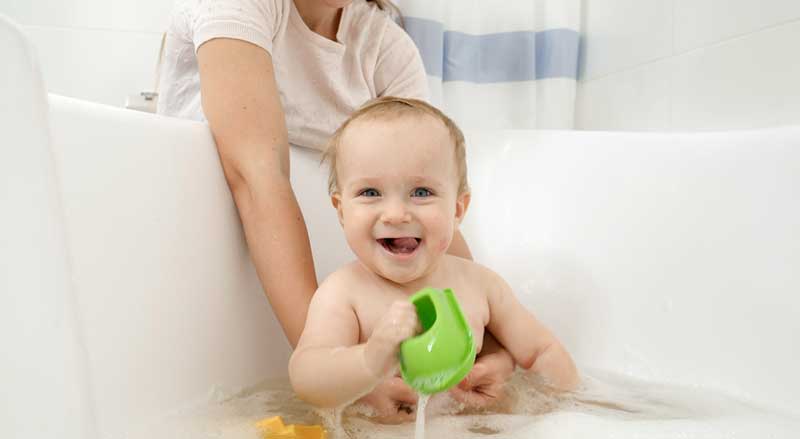
If you are bathing a young baby, always keep at least one hand on them. Make sure shampoo, soap, toys and towels are all within arm’s reach before your child is in the tub.
If your child sits on their own, stay within arm’s reach so you can act immediately should they need you.
Don’t get a false sense of security from baby bath seats. Seats can tip over or the baby can slip out.
Babies Don’t Need Lots of Water in the Tub
A baby doesn’t need much water in the tub. In fact, they will do well with only two inches of water. Don’t let the water be higher than your young child’s bellybutton. Use a plastic cup to pour water on their body during the bath.
Water and Air Temperatures
Always fill the tub and test the water’s temperature before you put your child in the water. You can test the water temperature by dipping your elbow into the running water.
If your elbow feels the water is too warm, it’s definitely too warm for your child’s sensitive skin. In this case, add cold water and swirl the water to get rid of hot spots.
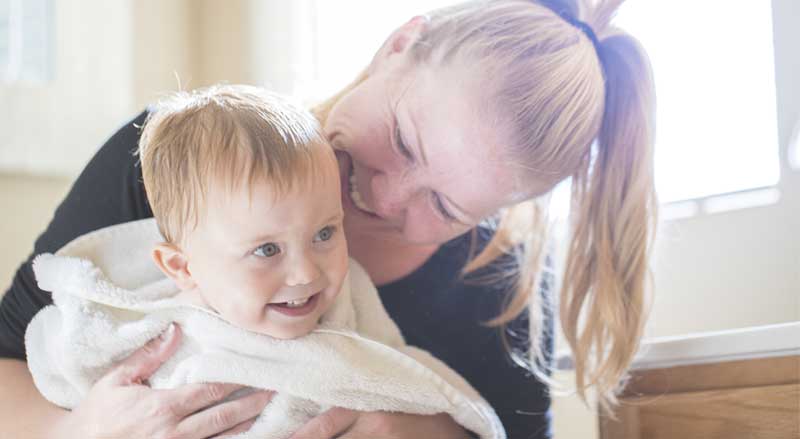
At bath time, set your home’s air temperature between 75°F and 80°F. This way your child won’t feel chilled when they get out of the water.
Keep your water heater set to 120°F or lower to keep burns from accidentally occurring if a toddler turns on the water themselves.
Kids Can Get Slippery!
Both kids and bathtubs can be slippery. So, it’s important to follow these safety rules:
- Keep anti-slip strips or a rubber floor mat at the bottom of the tub
- Be aware of water splashed on the floor
- Lift babies and younger children into and out of the tub while you are standing securely on a dry floor
- Make sure your child remains sitting in the tub
- Let your child know they are not to stand up in the bathtub or try to get out of the tub without your help
- Use waterspout covers to protect young heads from bumps
Additional Safety Measures
Never keep electrical appliances near the bathtub. Appliances, such as hair dryers, can inadvertently fall into the bath water. Keep bathroom appliances unplugged.
Always drain the tub right after your child’s bath.
Njswim and NJSSA – Two Leaders in New Jersey Water Safety
New Jersey Swim Safety Alliance (NJSSA) is a group of swim professionals devoted to promoting water safety and drowning prevention in New Jersey.
NJSSA offers these additional tips on water safety for at home, at the pool, and at the beach.
Njswim is a Gold Member of this important non-profit organization. Joe Oehme, Njswim’s President and Founder, is proud to also be a Founding board member of NJSSA.
Joe is known for his work promoting water safety and for Njswim Schools—a swim school with six locations in New Jersey that embrace a proprietary “Learn to Float” philosophy.
Njswim also offers these water safety tips for toddlers.
Njswim and NJSSA promote the importance of children taking swim lessons at an early age. The American Academy of Pediatrics reports that swimming and water safety classes add an extra layer of protection against drowning for kids as young as one year.
Contact Njswim for Water Babies classes and swim lessons for kids of all ages.

